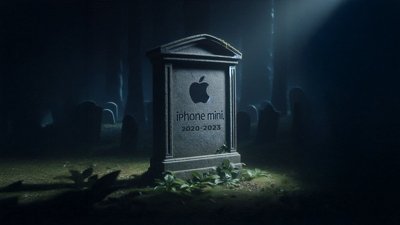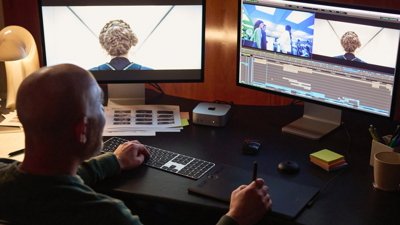Back in 1984, Apple had to bundle new Macs with instructions on how to use a mouse. Today, users don't need the same kind of hand-holding, although the company now includes videos within System Preferences to demonstrate how various multitouch gestures work.
Apple has increasingly stripped the Mac OS Human User Interface Guidelines of unnecessary chrome designed to show them how to do things (like resize windows, or reposition information within a window) that are now easier to discover, thanks to smoothly animated graphical transitions.
Apple's chief executive Steve Jobs demonstrated some of the new features of Lion back in September.
Overlay scrollbars
Many of these advances were pioneered by iPhone's iOS, including the removal of full sized scroll bars that tend to take up a significant strip of valuable real estate, particularly on mobile devices.
As was only hinted at previously, Mac OS X Lion will similarly draw only subtle "overlay scrollbars" when necessary, allowing them to fade away to avoid consuming area within windows.
As demonstrated in the video below, Lion's scrollbars can be directly interacted with using the pointer while they are visible, a trick that isn't possible on iOS.
Flexible window resizing
The Mac now gains the ability to resize windows from any edge or corner, similar to features exposed over twenty years ago by Jobs' NeXTSTEP operating system, but which were removed from Mac OS X in order to preserve the look and feel of the original Mac UI.
Lion exposes flexible window resizing without resorting to resize controls however; the edges of windows remain borderless, with only a pointer change indicating the directions a window boundary can be resized. Movie on page two.
Update: A developer reports that window resizing also supports standard modifier keys, so holding Shift while resizing a window from any edge constrains the window resizing to its existing aspect ratio, while holding Option resizes the window from its center point.
On page 2 of 2: Enhanced Finder features.
Specific to the Finder, Lion gets a revised source list, with simple monochromatic icons that look borrowed from the iPad. Also, rather than using triangle disclosure controls to hide item lists, the revised source list simply offers a "hide" button that appears when the pointer is nearby.
The Finder's "Places" is also replaced with "Favorites," and "Search For" is removed, with search queries now added as a gear icon under the Favorites list. Icons in the source list no longer disappear in a poof of smoke; they now require a right click to open a contextual menu that offers to remove the item, a more deliberate action that is harder to enact by mistake.
Finder views are presented with a new virtual physical slider control reminiscent of the iOS, and more items are presented as Cover Flow listings that can be flicked through by the user, indicating a shift toward intuitive, "hands on" multitouch navigation items.
A new Quick View panel presents previews within a light grey window rather than the translucent black "heads up display" of the existing Mac OS X, providing both a new full screen icon in the top right (rather than at the bottom, as it is currently). This control is now standard on many windows, providing a way to make an individual window a full screen view that gets rid of both the window controls and the system's menu bar, while still easy to escape from using the reappearing menu bar that drops down from the top. Again, more iOS simplicity that focuses on content rather than a complex user interface.
QuickView windows also present a button that can open the item being viewed, such as a Preview link for graphics (as depicted in the video) or an option to open a volume or folder in its own window. The green Zoom button now works consistently as a control to optimize the size of the window to fit its contents, leaving the full screen button to do a separate task.
Enhanced Gestures
Apple has also demonstrated a series of gestures that can be used to open Launchpad, invoke Mission Control for moving between full screen apps (which are each located in their own virtual desktop via Spaces), Dashboard, and other open programs and their applications, as well as navigating between web pages and within pages using new Double Tap to Pinch to Zoom features borrowed from iOS.
 AppleInsider Staff
AppleInsider Staff






-m.jpg)






 Christine McKee
Christine McKee
 Wesley Hilliard
Wesley Hilliard
 Thomas Sibilly
Thomas Sibilly
 Marko Zivkovic
Marko Zivkovic
 Andrew O'Hara
Andrew O'Hara
 Amber Neely
Amber Neely
 William Gallagher
William Gallagher









127 Comments
Why do you insist in writing for AI under two names?
It's good to see so much thought going into this. Most companies would declare their user interface a 'solved problem', and let it go at that.
Interesting. I think a lot of this stuff make take me some time to get used to, simply because the current processes are so engrained. However, most of that looks *very* cool.
I'm definitely looking forward to Lion.
Why do you insist in writing for AI under two names?
Quite laughable, indeed.
I am using it now and it's polish so far is excellent, have no doubt that the retail GM will excite and put a smile on your face.